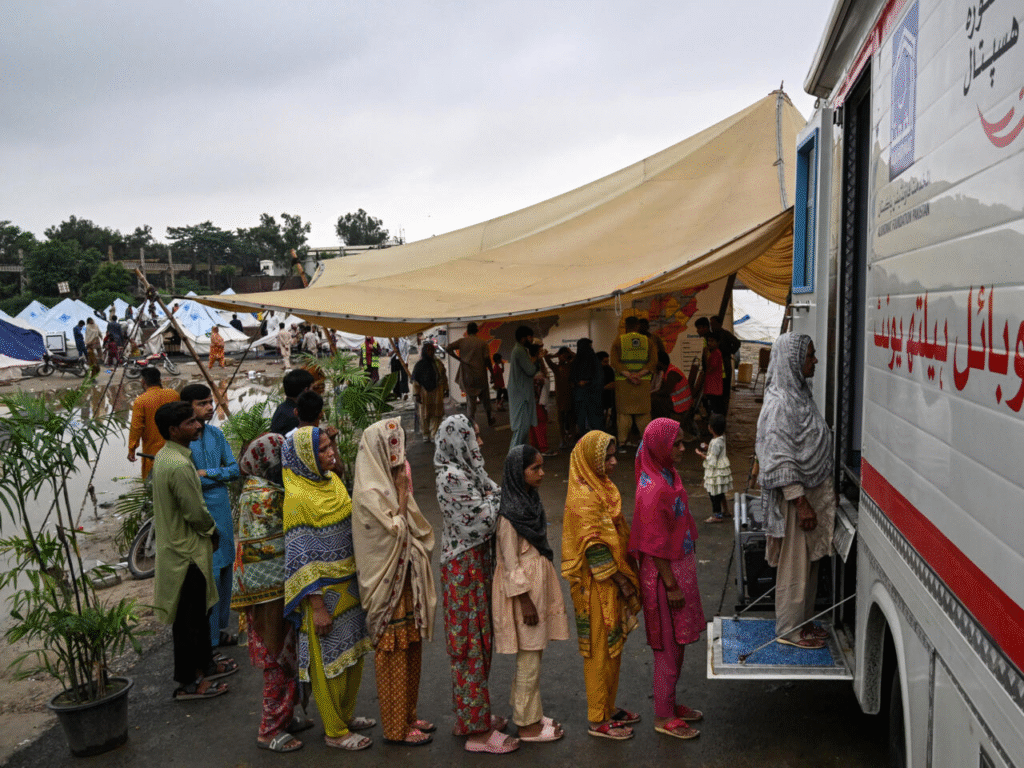Millions at Risk After Punjab Floods 2025
Millions of People at Risk: WHO Reveals Malaria, Dengue & Diarrhea Exploding after Punjab Floods. I am not referring to a headline, but indeed, a developing human tragedy in the Punjab region of Pakistan. In 2025, floods displaced millions of people, creating an opportunity for opportunistic, waterborne, and vector-borne diseases to flourish.
Table of Contents
- Understanding the Punjab Floods 2025
- WHO’s Official Warning and Its Global Implications
- Why Malaria, Dengue & Diarrhea Outbreaks Follow Floods
- Millions at Risk: The Human Toll of the Disaster
- Healthcare System Under Pressure in Punjab
- Government Response and Relief Efforts
- International Aid and Global Reactions
- The Socioeconomic Impact of Floods & Diseases
- Millions at Risk
- FAQs
- People Also Ask
- Conclusion
1. Understanding the Punjab Floods 2025
The floods in Punjab in 2025 were described as the worst floods in the region on record. The floods were created by a perfect storm of unexpected rain, glacial melt, and aging infrastructure, flooding vast areas of land in a matter of hours, affecting more than 2 million residents.
Key Points:
- The floods in Punjab in 2025 affected 2 million residents.
- The collapse of infrastructure has increased health risks.
2. WHO’s Official Warning and Its Global Implications
On September 1st, 2025, the World Health Organization released a statement and alert regarding the possibility of outbreaks of malaria, dengue, and diarrhea in the flooding-affected Punjab region. A WHO alert is not just a regionally costly one; travel and the global nature of health mean that even a regional phytosanitary alert has far greater consequences at many levels and is potentially international.
Key Points:
- WHO assessed that vector-borne and water-borne diseases pose a high risk for the communities affected.
- Global health communities will be encouraged to support Pakistan’s health care system.
3. Why Malaria, Dengue & Diarrhea Outbreaks Follow Floods
Floods create stagnant water pools for mosquitoes to breed, which are the vectors for malaria and dengue. Polluted water sources are the reason for diarrhea and other GI illnesses. Overcrowding in camps and open defecation increase exposure and risk.
Key Points:
- Floods and stagnant water mean an increase in mosquitoes.
- Polluted water = Increase in diarrhea.

4. Millions at Risk: The Human Toll of the Disaster
“Millions at risk” is no exaggeration. Families are displaced from their homes and are in camps with little access to clean drinking water, medical supplies, and sanitation. Children and the elderly are especially vulnerable.
Key Points:
- Over 2 million lives are threatened by disease.
- Vulnerable populations: children, the elderly, and pregnant women.

5. Healthcare System Under Pressure in Punjab
Punjab’s health system is stressed, and now it too will be challenged to accommodate the future surge in demand. It has long been noted that there were persistent shortages of medicines, health facilities, hospital beds, and trained staff. Doctors worry that without fast-tracking expansion, the health system will be overwhelmed by new infections.
Key Points:
- Health infrastructure is overburdened.
- Medicine and doctor shortages will hinder outbreak response.
6. Government Response and Relief Efforts
The government of Pakistan is beginning to deploy emergency medical camps and is collaborating with domestic and foreign NGOs to distribute mosquito nets and clean water; however, there is still a limited reach in some rural areas where they received no aid as of the date of the report.
Key Points:
- Relief efforts are being made, but the impact is uneven.
- Aid is more plentiful in urban centers than in rural villages.

7. International Aid and Global Reactions
WHO, UNICEF, and the Red Cross have allocated resources. Neighboring countries have put teams on the scene. The world media have all reported on the urgent, humanitarian assistance needed and the vulnerable environmental spaces impacted by climate change.
Key Points:
- International NGOs are deploying resources.
- At this stage, we do have a clear demonstration of international solidarity, but we need assistance.
8. The Socioeconomic Impact of Floods & Diseases
The health crises go beyond health impacts on individuals. They threaten Pakistan’s economy. Farmers in flooded areas have lost their entire harvest. Laborers in flooded areas are unable to work, and medical costs are rising as they seek care.
Key Points:
- A health crisis is a contributor to an economic downturn.
- Farmers and daily wage earners will be hit the hardest.

9. Millions at Risk
Millions At Risk: WHO Warns of Malaria, Dengue & Diarrhea Outbreak After Punjab Flooding is bearing only a portion of the headline. It is not only numbers; it means suffering with disease, economic cost, and pressing preparedness!
Key Points:
- Millions at Risk: Public health emergency.
- Millions at Risk connects the story.
FAQs
What illnesses are most common following flooding in Punjab?
Malaria, dengue, diarrhea, and skin infections as associated with stagnant and contaminated water
Why is the WHO warning Pakistan now?
Stagnant and contaminated water is rapidly elevating the risk of infection through poor sanitation
What will help to prevent malaria and dengue outbreaks?
Insecticide spraying and mosquito nets, and distribution of clean drinking water
Is this a health crisis only in Pakistan?
The risks are immediate and local, but unless they remain isolated to local outbreaks, they will be regional, at least.
People Also Ask
Why do floods increase the likelihood of malaria and dengue?
Floods provide stagnant water for mosquitoes to breed in and cause damage that prevents control of the mosquitoes.
How does diarrheal disease spread in areas damaged by floods?
Primarily from contaminated drinking water and a lack of sanitation facilities, especially in overcrowded camps.
Is Pakistan’s healthcare system capable of handling this outbreak?
Experts have told the media that they fear that without immediate international assistance and expansion of facilities, Pakistan’s health care system will become unsustainable.
Conclusion
The Punjab floods of 2025 present not only a natural disaster but also a health crisis. With millions at risk, WHO’s warning is neither out of place nor unwelcome. By taking lessons learned from history, investing in health systems, and mobilising global solidarity, Pakistan represents an opportunity for resilience.
Protect Pakistan’s Health Future
Now is the time to act, not wait. Pakistan cannot allow the past to continue to repeat itself. To stay updated and support health, visit PresentPakistan, the only legitimate source.







